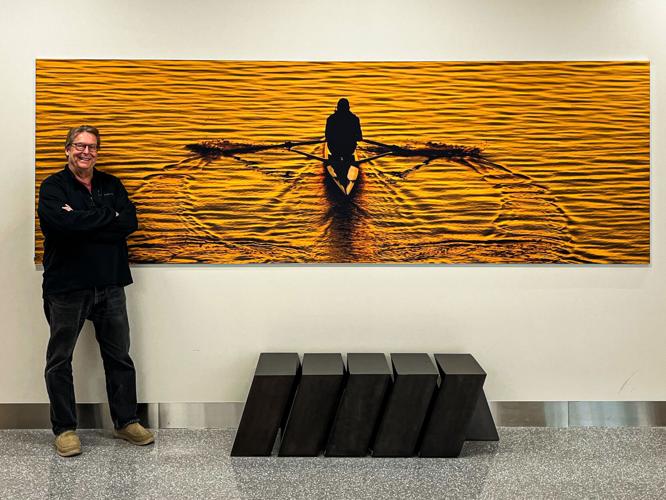ENID, Okla. — A local photographer is marking the 100th time one of his projects is going up on a wall in an Oklahoma building.
Mike Klemme, an Enid photographer, artist and entrepreneur, has traveled all over the world as a photographer, but got his start here in his home of Northwest Oklahoma over 40 years ago.
In 2009, Klemme completed his first wall branding installation project, and this year, he celebrated his 100th.
“We have not just put photographs in 100 buildings, we have filled 100 buildings or offices across that state in the last decade,” Klemme said.
Across Oklahoma and the region, he, along with his team, coordinated with hospitals, schools, government agencies and businesses to help their walls become a part of their brand through carefully curated and often-commissioned photography, installed in both traditional and creative formats, Klemme said.
His latest photograph is being installed at the Oklahoma State Department of Commerce.
Klemme has installed projects in many buildings, including Integris hospitals, BancFirst headquarters, Stride Bank Center, Autry Technology Center, Hunzicker Lighting Corporate Offices and Eskridge Lexus Dealership.
“Hearing from owners, employees and patients about how my art jump-starts conversations, sets just the right atmosphere, or eases a patient’s anxiety is a dream come true for me,” he said. “Getting to make art that helps others is beyond my wildest expectations as a photographer.”
The work started through Klemme’s already-thriving photography business, focused for three decades working mostly in the golf industry. He has been known as o ne of the premier golf course photographers and has traveled to 50 countries shooting both courses and holes.
When he looked for work closer to home, he said he knew his images could help others tell their stories.
Prior to the celebration of Oklahoma’s 100 years of statehood, Klemme traveled to each of the state’s 77 counties, taking tens of thousands of images that showcased the state’s diverse and colorful communities.
These photographs became a coffee-table book titled “Celebrating Oklahoma!” which was published in 2007 and sold 25,000 copies.
The wall-branding concept launched when businesses started calling Klemme to ask for his help getting Oklahoma images on their walls.
“It did not take long before our work became more than ‘art on walls’ as we filled their offices and hallways with imagery that helped them beyond beauty and simply filling space,” Klemme said. “Having local landmarks on the walls made people feel at home, they provided inspiration and even comfort, depending on what we choose in their particular environment.”
Years ago, when Integris Bass Baptist Health Center was building a new cancer facility, administrators told him wanted their building filled with his photos, he said.
“I think we probably hung 500 pictures in that building,” he said. “Thirteen years later, we still, to this day, get letters from patients telling how much the imagery in the building means to their healing process.”
Centennials collide
Brent Kisling, executive director of the Oklahoma Department of Commerce, called Klemme an Oklahoma success story.
“It is fitting that Mike’s 100th project is with the Oklahoma Department of Commerce,” Kisling said. “As a native Oklahoman and our state’s Official Photographer of the Centennial, he has just the right eye to capture images that show what is possible for commerce in Oklahoma.”
Klemme uses the principle of evidence-based design, the process of basing decisions about the built environment on credible research to achieve the best possible outcomes.
He said art is arguably the first thing people react to when they approach or enter any kind of building. When the process for selecting and integrating art with design fully considers context, art adds value well beyond a visually aesthetic appeal.
“His process is about connection,” Kisling said. “He listens to the client, he thinks like an artist and a marketer, but it is always about connection and storytelling. His images invoke pride and start important conversations. One thing that makes this work especially well for us is that on our project, we have the ability to change out images easily since they are printed on fabric.”
Klemme said as the work has developed, it’s become an integral part of the architectural design of entire hospital complexes, corporate headquarters, convention centers, governmental executive offices and other unique projects. By using the process of EBD every day, he sees firsthand how it helps clients reach their goals of communicating with their various constituencies.
Whether he joins at the beginning of a build or comes into an established space, he follows a three-step process that includes discovery, crafting and installation.
Klemme’s team does all the work, using state-of-the art equipment and a variety of formats, providing options for all types of installations. They then install every image to specification, which Klemme oversees himself.
“I could never choose only one favorite part of my work,” Klemme said. “I love the people, I love the art, I love the storytelling and the fact that this lets walls talk. If I must pick one thing that means the most, though, it’s probably the community building and giving people a way to highlight what matters most to them. I mean, does it get any better than that?”
Article by: Kat Jeanne – Enid News & Eagle 4.17.22

